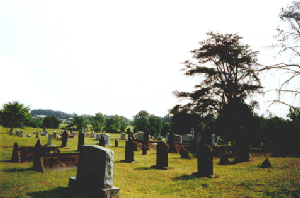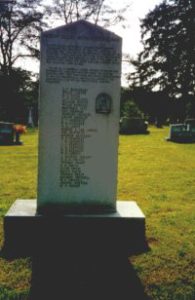Mt. Gilead United Methodist Church
In 1826, a Methodist church was organized southwest of Sparta in White County, Tennessee. It was named Mount Gilead, which means a hill of witness. According to church records and historical records of the Tennessee Conference, the Rev. Wesley Deskin was the first pastor. After serving for four years, he died in 1830, and was buried in Warren County.
The first church building, which was approximately 18 x 24 feet in size, was in harmony with the rural type of architecture of that period. It was constructed of logs with a large fire place and chimney at one end, and a door at the opposite end. The pew s were split logs supported by long pegs or legs.
The date of construction of the first building is unknown, but it was located on the northeast corner of a three acre tract of land owned by Washington Webb. On January 10, 1843, Mr. Webb deeded the tract to the Methodist Episcopal Church and for the use and benefit of schools…..with access to Webb Cave Spring water. The church trustees were James Arnold, John Herd, Samuel H. Keathley, Willis Keathley, and Thomas Roberts.
In 1845, Mt. Gilead joined with other Methodist churches in White County to become part of the Methodist Episcopal Church, South.
For many years in the early history of Mt. Gilead, camp meetings were held on the church grounds during the summer months. Families of the congregation would bring food and bedding and camp for several days. Sunrise prayer services were held each day in separate sections for men and women. Great revivals resulted from these camp meetings.
The large cemetery was begun before the Civil War and several soldiers are known to be buried there. Perhaps many of those rest in some of the unmarked graves in the older part of the cemetery. Many of the oldest graves are covered with sandstone slabs and have markers of the same material. Many of these stones were quarried on nearby Gum Spring Mountain by Thomas R. Keathley who was the father of Isaac W. and William R. Keathley, two of Mt. Gilead’s members entering the ministry.
On October 17, 1908, one acre of land north of the original three-acre tract was bought from Montgomery Carter and wife Emma, for the sum of $100, thus providing for the enlargement of the cemetery.
It is historical fact that in many communities the log church also served as the school building. Although no record has been found of a Mt. Gilead school, there are two indications that the log church may have served in that capacity. First, for the use and benefit of schools was a provision of the 1843 deed made by Washington Webb to the Methodist Episcopal Church for the three acres of land and the log church located thereon. Second, the Quarterly Conference record for August 17, 1889, includes the following report from A.O. Jett, chairman of Mt. Gilead Church trustees. Mt. Gilead Church and three acres of land valued at $1800 deed received in connection with Public School. Since then the school commissioners have sold their interest to the church and a debt of about five dollars delays the perfecting of a deed.

The 33 historic preachers listed on the monument are S. F. Burkhead Willie Carter D. C. Cook A. G. Copeland William Dinges Willie Dodson Marshall Gist Edd Graham Charley Hensley Logan Hensley E. F. Hudgens R. H. Hudgens H. M. Jarvis Robert E. Lee Jarvis Abe Keathley Andrew Keathley H. P. Keathley I. W. Keathley J. G. Keathley S. M. Keathley W. R. Keathley W. B. Lowrey J. Allison Molloy N. B. S. Owings Thomas Smart C. B. Smith David Smith Hayes Smith Thomas Sweat Raymon Swindell W. P. Swindell Joseph Webster M. P. Woods
The second building, a frame structure located a short distance southwest of the log church, was erected in 1878. C.N. Blake was foreman of the building committee and was the only person to receive pay for his work. The remainder of the labor and all ma terials were donated. This building continued to serve as a center for worship in the community for seventy-two years.
Among those who worshipped in the white frame church were 33 young men who later entered the Christian ministry to spread the gospel in various denominations in several different states. According to the United Methodist Conference, Mt. Gilead has suppli ed more ministers than any other single church of any denomination in America. It is not possible to estimate the service that they rendered. Many souls were brought to Christ through their ministry, and many churches were built under their supervision. This number includes six sets of brothers: R.H. and E.F. Hudgens, H.M. and Robert E.L. Jarvis, Hayes and David Smith, Isaac W. and William R. Keathley, Waymon and W.P. Swindell, John Casto and Samuel Milo Keathley. During their active years in the ministry, William R. Keathley and Isaac W. Keathley were privileged to return to Mt. Gilead while serving as pastor of the Sparta Circuit. Also, H.M. Jarvis and R.H. Hudgens ministered to Mt. Gilead while serving as Presiding Elder of the Cookeville District.
All of the thirty-three ministers are deceased and Mt. Gilead cemetery served as the burial site for five of them — Edd Graham, Logan Hensley, Isaac W. Keathley, Charles B. Smith and W.P. Swindell. Rev. Smith, the last to enter the ministry from Mt. Gil ead, died in 1973. He and Mrs. Smith (Henrietta) lived at Rock Island after his retirement in 1962 and attended worship services at Mt. Gilead when health permitted. Among his prized possessions was a yellow poplar table with a lazy susan made from the pew o n which he sat as a boy.
Quarterly Conference records indicate that Sunday school was organized in 1883 with James B. Woods, father of the Rev. M.P. Woods serving as superintendent. By 1887, the enrollment had reached one hundred twenty and Mt. Gilead was the only church on the Sparta Circuit whose Sunday school did not dismiss during the winter months each year.
After 1939 the pastor served no more than five churches on the Sparta Circuit. Not only did the pastor serve several churches, but the salary was small. For 1934-35, the pastor’s salary from all churches was $600. In those days, it was necessary for th e stewards to visit church members to secure payment of the pastor’s salary before each quarterly conference. Money was not always available, so payment was frequently made in food- – – -home canned fruits and vegetables, meat, chickens—-whatever the farm family could contribute.
